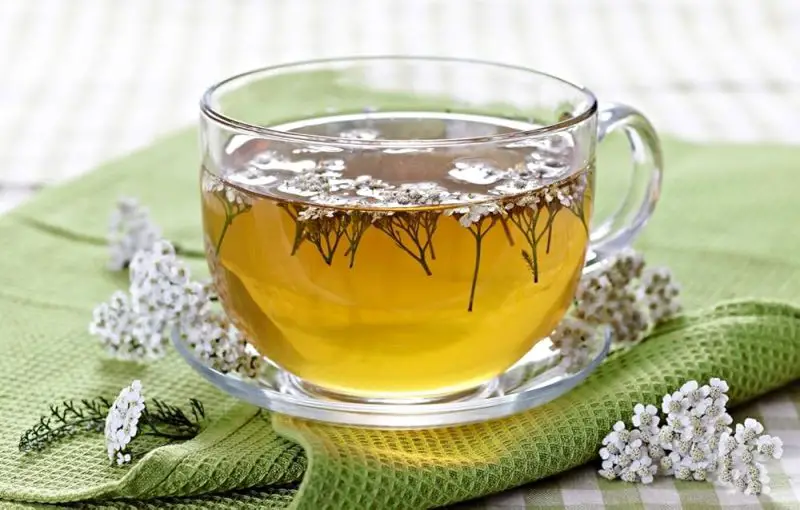Yarrow tea is a gentle, aromatic herbal infusion prized for its calming effects and natural wellness benefits. Known for centuries as a traditional remedy, yarrow supports digestion, reduces inflammation, and promotes relaxation. Making tea at home allows you to harness these properties easily, transforming simple garden-harvested leaves and flowers into a soothing, healthful beverage.
Beyond its medicinal value, yarrow tea offers a sensory experience that connects you with nature. Brewing a fresh cup encourages mindfulness and appreciation for the garden, while its delicate floral aroma enhances daily routines. By learning proper harvesting, preparation, and brewing techniques, you can enjoy the full benefits of yarrow tea while supporting a sustainable, thriving herbal practice.
Understanding Yarrow for Tea

Botanical Characteristics
Yarrow is a hardy perennial known for its feathery, fern-like foliage and dense clusters of small, vibrant flowers that range from white to yellow or pink. Its aromatic leaves and flowers contain essential oils, flavonoids, and tannins, which contribute to both the flavor and medicinal properties of yarrow tea. Growing well in well-drained soil and full sunlight, yarrow is accessible for home gardeners and herbalists alike.
The plant’s structure and chemical composition make it particularly suited for herbal infusions. Leaves contribute a mild bitterness and healthful compounds, while the flowers add a subtly sweet aroma that balances the flavor. Selecting mature, healthy plants ensures maximum potency and an enjoyable drinking experience. Understanding these botanical characteristics allows gardeners to harvest the right plant parts at the ideal time, optimizing both taste and therapeutic benefits.
Historical and Traditional Uses
Yarrow has a long history of use across cultures for its medicinal and therapeutic properties. Traditionally, it has been brewed into teas to aid digestion, soothe colds, and support wound healing. The plant’s natural anti-inflammatory and calming properties made it a staple in folk medicine, with flowers and leaves often included in daily herbal routines.
In addition to health purposes, yarrow held symbolic and ceremonial significance in many traditions. Its aromatic qualities and visual appeal contributed to rituals and calming preparations, demonstrating the plant’s versatility beyond physical wellness. Recognizing these historical and traditional uses enriches the process of making yarrow tea, connecting modern herbal practices with centuries of natural wisdom and highlighting the multifaceted benefits of this resilient perennial.
Harvesting Yarrow for Tea
Harvesting yarrow correctly is essential to maximize both its flavor and therapeutic benefits. The plant’s leaves and flowers are the primary components used for tea, with each part contributing unique properties. Leaves provide mild bitterness and nutrients, while flowers add aromatic sweetness and flavonoids that enhance both taste and medicinal value. For the best results, harvesting should take place during peak bloom, ideally in the morning after dew has evaporated. Morning collection preserves the plant’s essential oils, ensuring a potent and aromatic infusion. Avoid harvesting discolored, damaged, or woody stems, as these can compromise both flavor and quality. Selecting vibrant, healthy foliage guarantees that your tea is not only enjoyable but also rich in beneficial compounds.
Sustainable harvesting practices are crucial to maintain the long-term health of yarrow plants. Only remove up to one-third of the plant at a time, leaving enough leaves and flowers for photosynthesis and natural growth. Alternating harvest areas and allowing different sections of the plant to bloom fully ensures that the yarrow remains productive throughout the season. Mindful harvesting also supports pollinators, which rely on yarrow blooms for nectar. By balancing collection with the plant’s natural cycles, gardeners can enjoy repeated harvests without weakening the plant or diminishing its aesthetic appeal.
Additionally, proper handling post-harvest contributes to the tea’s quality. Gently shake off dirt and debris, and rinse if necessary, being careful not to bruise the leaves or flowers. After cleaning, the plant material can be used fresh or dried for later use. Drying in a well-ventilated, dark area preserves essential oils and extends shelf life. Careful selection, sustainable harvesting, and proper post-harvest handling ensure that every cup of yarrow tea is flavorful, potent, and beneficial for both body and mind.
Preparing Yarrow for Tea
Proper preparation of yarrow is essential to create a flavorful and potent tea. After harvesting, the leaves and flowers should be carefully cleaned to remove dirt, insects, or any debris. Gently shaking or rinsing with cool water helps maintain the integrity of the plant material without bruising it. Selecting only healthy, vibrant leaves and fully opened flowers ensures maximum aromatic and medicinal quality. Discarding damaged or discolored parts preserves the flavor and prevents any bitterness or off-taste in the infusion.
Once cleaned, the next step is drying the plant material if you plan to store it for later use. Air-drying is the preferred method for home gardeners, as it preserves essential oils and active compounds. Bundles of yarrow should be hung upside down in a dark, well-ventilated space until fully dry. Once dried, the leaves and flowers can be stored in airtight containers, away from light and moisture, maintaining their aroma and potency for months. Using properly dried yarrow ensures a consistent, flavorful, and therapeutic tea any time of the year.
Fresh yarrow can also be used immediately for tea preparation, offering a milder and more delicate flavor than dried material. Fresh leaves and flowers retain higher moisture content and volatile compounds, which can create a lighter, aromatic infusion. When using fresh yarrow, it is important to remove excess stems and ensure that all parts are clean and free from impurities. Whether using fresh or dried yarrow, careful preparation maximizes both taste and health benefits, transforming simple garden-harvested plant material into a nourishing and aromatic herbal beverage.
Brewing Techniques
Basic Steeping Method
Brewing yarrow tea using the basic steeping method is simple yet highly effective in extracting both flavor and therapeutic compounds. Begin by adding one teaspoon of dried leaves and flowers per cup of boiling water. Pour the hot water over the plant material and cover the cup to trap heat and aromatic oils. Covering is essential, as it preserves volatile compounds that contribute to flavor, aroma, and health benefits. Uncovered tea may lose its delicate scent and essential oils to evaporation, resulting in a weaker infusion.
Steeping time is a critical factor in balancing potency and taste. Typically, five to ten minutes of steeping produces a pleasantly aromatic and flavorful tea. Extending the steeping period enhances medicinal properties but may introduce bitterness, so it is important to adjust the duration according to personal preference. Covering the tea while it steeps ensures maximum retention of bioactive compounds, producing a rich, soothing beverage that promotes digestion, relaxation, and overall wellness.
Using Tea Infusers or Strainers
Combining with Other Herbs
Yarrow blends exceptionally well with herbs such as chamomile, peppermint, lemon balm, or even lavender, enhancing both flavor and therapeutic effects. Chamomile complements yarrow’s floral notes with gentle sweetness and calming properties, making the tea particularly soothing for relaxation and stress relief. Peppermint adds a refreshing, cooling element that brightens the infusion while supporting digestion. Lemon balm contributes mild citrusy aroma and calming effects, creating a balanced, multi-layered herbal experience. Thoughtful combinations allow you to craft teas tailored to personal taste and wellness goals, whether promoting relaxation, aiding digestion, or simply enjoying a fragrant, flavorful beverage.
Maintaining the right proportion of herbs is crucial to ensure yarrow’s delicate floral notes remain prominent. Using too much of a stronger herb, such as peppermint, can overpower the subtle flavor of yarrow, diminishing the tea’s signature profile. Start with small quantities and gradually adjust based on taste preferences and desired effects. Experimenting with different ratios allows for customization of both flavor and potency, creating a unique infusion every time. By blending herbs mindfully, each cup of yarrow tea becomes a harmonious combination of aroma, taste, and therapeutic benefit, offering a personalized and enjoyable herbal wellness experience.
Health Benefits of Yarrow Tea
Digestive Support
Yarrow tea has long been valued for its ability to support digestive health. Its natural compounds stimulate the production of digestive enzymes, easing discomfort from bloating, gas, or mild cramps. A warm cup of yarrow tea after meals can soothe the stomach and help food pass more comfortably through the digestive tract. The gentle action of yarrow makes it suitable for regular use, providing a natural alternative to over-the-counter remedies while avoiding harsh chemicals.
In addition to immediate relief, regular consumption of yarrow tea may promote long-term gut health. Its anti-spasmodic properties help maintain smooth digestive function, supporting overall comfort and well-being. Integrating yarrow tea into daily routines encourages mindful consumption, allowing individuals to enjoy both the sensory pleasure of a flavorful herbal infusion and its digestive benefits. Over time, it can become a comforting ritual that enhances both health and relaxation.
Anti-Inflammatory Properties
Yarrow is rich in flavonoids and tannins, compounds known for their anti-inflammatory benefits. Drinking yarrow tea may help reduce inflammation in various parts of the body, supporting joint comfort, alleviating minor aches, and calming irritation in the digestive system. Its mild, aromatic infusion provides a gentle, natural way to support the body’s immune response and overall wellness. Unlike stronger remedies, yarrow tea offers a soothing approach that can be integrated easily into daily routines without causing harsh side effects.
Including yarrow tea regularly in an herbal wellness regimen can contribute to ongoing management of low-level inflammation. The combination of flavor, aroma, and active compounds creates a beverage that nourishes the body while providing a moment of calm and relaxation. Over time, consistent consumption may complement other healthy habits, such as a balanced diet and exercise, enhancing overall physical and mental well-being. Yarrow tea’s holistic properties make it a versatile tool for supporting natural healing processes and promoting sustained comfort, making it a valuable addition to any wellness-focused lifestyle.
Relaxation and Stress Relief
Yarrow tea is widely appreciated for its calming and soothing qualities, making it an ideal choice for managing stress and promoting mental clarity. Its gentle bitterness, combined with a subtle floral aroma, creates a sensory experience that naturally encourages mindfulness and relaxation. Drinking yarrow tea slowly allows individuals to pause, focus on the present moment, and release accumulated tension, contributing to emotional balance and a sense of inner calm.
In addition to stress relief, yarrow tea can support restful sleep when enjoyed in the evening. Its mild, naturally relaxing compounds help the body and mind transition into a state conducive to restorative rest. Beyond bedtime, yarrow tea is versatile, offering a cooling, refreshing option when brewed iced during warm days, still providing gentle relaxation. Integrating yarrow tea into daily routines enhances overall well-being, combining flavor, aroma, and natural therapeutic properties. Regular consumption encourages holistic wellness, allowing the mind and body to unwind while benefiting from the plant’s calming and restorative effects.
Maximizing Flavor and Potency
Adjusting Steeping Time
Steeping yarrow for the right duration is crucial to achieving a balanced cup of tea with both pleasant flavor and optimal therapeutic benefits. A shorter steeping period, around three to five minutes, typically produces a lighter, more delicate infusion that highlights the tea’s subtle floral notes. This approach is ideal for those who prefer a milder taste or enjoy multiple cups throughout the day without overwhelming bitterness. Conversely, longer steeping, between eight to ten minutes, extracts stronger flavors and more bioactive compounds, enhancing the tea’s potency for medicinal purposes.
Covering the tea while it steeps helps preserve volatile essential oils, which contribute to both aroma and therapeutic efficacy. Adjusting steeping time based on personal taste and desired strength allows for a customized tea experience. Experimentation is key, as different batches of yarrow may vary slightly in flavor intensity and potency. By paying attention to steeping duration and maintaining proper techniques, drinkers can consistently enjoy a fragrant, soothing, and healthful cup of yarrow tea that meets both flavor preferences and wellness goals.
Using Fresh vs. Dried Yarrow
Fresh yarrow leaves and flowers provide a delicate, subtly aromatic tea with a mild, floral flavor. Using fresh plant material preserves natural moisture and volatile oils, creating an infusion that is light and refreshing. Fresh yarrow is ideal for immediate consumption and for those who prefer a softer, gentler taste while still obtaining the plant’s calming and digestive benefits. Proper harvesting and gentle handling are important to maintain quality, ensuring that leaves and flowers are free from debris and undamaged.
Dried yarrow, on the other hand, produces a stronger, earthier infusion with more concentrated flavors and medicinal compounds. The drying process preserves essential oils and allows for longer storage, making it convenient for year-round use. Combining fresh and dried yarrow can offer a balanced profile, capturing both aromatic freshness and robust herbal potency. Understanding the differences between fresh and dried forms helps tea enthusiasts select the right approach for taste preference, desired strength, and intended health benefits, ensuring a satisfying and effective yarrow tea experience.
Enhancing with Natural Additions
Yarrow tea can be complemented with natural additions such as lemon, honey, or other herbs to enhance both flavor and therapeutic value. Lemon brightens the infusion with a fresh, citrusy note while adding vitamin C and additional antioxidants. Honey introduces mild sweetness and soothing qualities, making the tea more palatable while supporting throat comfort and relaxation. Herbs like peppermint or chamomile can add complexity to the flavor profile and provide synergistic health benefits, such as digestive support or enhanced calming effects.
Experimenting with combinations allows tea drinkers to create personalized infusions tailored to their taste preferences and wellness goals. Adjusting the quantity and choice of additives ensures that yarrow’s subtle floral notes remain prominent without being overpowered. Thoughtful enhancements not only improve the sensory experience but also expand the tea’s potential benefits, making each cup both enjoyable and healthful. By exploring natural additions mindfully, yarrow tea becomes a versatile and adaptable herbal beverage suitable for various occasions and purposes.
Storing Yarrow Tea
Dry Tea Storage
Dried yarrow tea requires careful storage to maintain its flavor, aroma, and therapeutic properties. Placing the dried leaves and flowers in airtight containers helps protect them from moisture, which can cause mold or degradation of essential oils. Keeping the containers in a cool, dark location further preserves the delicate compounds responsible for the tea’s subtle floral taste and health benefits. Exposure to sunlight or heat accelerates loss of flavor and potency, reducing the effectiveness and enjoyment of the infusion.
Labeling containers with harvest dates is a practical way to monitor freshness and ensure proper rotation of stock. Glass jars with tight-fitting lids or metal tins are ideal for long-term storage, as they prevent contamination while maintaining optimal dryness. Properly stored dried yarrow can remain usable for several months, allowing for convenient access to a consistent, high-quality herbal tea. By following these storage practices, tea drinkers can maximize both flavor and wellness benefits from their yarrow harvest.
Fresh Tea Storage
Freshly harvested yarrow offers the advantage of immediate brewing but requires careful short-term storage to maintain its quality. To preserve leaves and flowers, wrap them in a slightly damp paper towel and place them in a sealed bag or airtight container. This method helps retain moisture without promoting mold growth and preserves the plant’s aromatic oils and subtle flavor for a few days.
Fresh storage ensures quick access to a vibrant, aromatic tea, ideal for those who prefer the lighter, delicate taste of recently harvested yarrow. Because fresh leaves and flowers are more perishable than dried ones, it is important to consume them promptly. Careful handling and refrigeration allow tea enthusiasts to enjoy the maximum potency and sensory experience from each harvest, making fresh yarrow tea a flavorful and healthful option for immediate consumption.
Precautions and Considerations
Allergies and Sensitivities
Yarrow tea is generally well-tolerated, but caution is necessary for individuals sensitive to plants in the Asteraceae family, including ragweed, daisies, and marigolds. Those with known allergies may experience reactions such as skin irritation, hives, or respiratory symptoms when consuming yarrow. To minimize risk, start with a very small amount of tea and monitor for any adverse effects. Consulting a healthcare provider before introducing yarrow into the diet is recommended for those with a history of plant allergies.
Being aware of potential sensitivities allows individuals to enjoy yarrow tea safely. Proper testing and observation help prevent unexpected reactions and ensure a positive experience. With mindful introduction, most people can benefit from yarrow’s digestive, anti-inflammatory, and relaxing properties without discomfort. Awareness and caution are key to integrating yarrow tea safely into a wellness routine while maximizing enjoyment and therapeutic effects.
Pregnancy and Medication Interactions
Yarrow contains compounds that can influence uterine contractions, making it potentially unsafe for pregnant or breastfeeding women. Regular consumption during pregnancy is not recommended, as it may pose risks to both mother and baby. Additionally, yarrow may interact with certain medications, including blood thinners and drugs affecting blood pressure or blood sugar. Consulting a healthcare provider before use ensures safe integration into daily routines.
Being mindful of these interactions is essential for maintaining safe herbal practices. Awareness helps prevent unwanted side effects and ensures that yarrow tea supports wellness without complications. By following medical guidance, individuals can enjoy the benefits of yarrow tea while minimizing health risks, making it a responsible choice for those mindful of safety.
Moderation in Consumption
Even though yarrow tea offers many benefits, excessive intake can lead to mild digestive issues, dizziness, or headaches. Drinking several cups in a short period may overwhelm the body, causing temporary discomfort. Limiting consumption to one to three cups per day is generally sufficient to gain the tea’s digestive, anti-inflammatory, and relaxing effects without negative outcomes.
Monitoring how the body responds to yarrow tea allows for safe, personalized use. Adjusting intake based on tolerance ensures maximum benefits while avoiding adverse reactions. Moderation is essential to incorporate yarrow tea responsibly into daily wellness routines. By consuming it thoughtfully, individuals can enjoy a flavorful, calming, and healthful beverage that supports overall well-being safely and effectively.
FAQ About How to Make Yarrow Tea at Home
What is the best time to harvest yarrow for tea?
The ideal time to harvest yarrow is during its peak bloom, usually mid to late summer. Collect fresh leaves and flowers in the morning after dew evaporates to ensure maximum essential oils, flavor, and therapeutic properties. Proper timing ensures a potent and aromatic tea with optimal health benefits.
Can I use both fresh and dried yarrow for tea?
Yes, both fresh and dried yarrow are suitable for tea. Fresh yarrow provides a delicate, floral flavor, while dried leaves and flowers offer a stronger, earthier taste. Combining both can balance flavor and potency. Proper storage and handling are essential to maintain therapeutic qualities in either form.
Are there any side effects of drinking yarrow tea?
Yarrow tea is generally safe, but excessive consumption may cause mild digestive discomfort, dizziness, or allergic reactions in sensitive individuals. People allergic to ragweed or daisies, pregnant women, or those on certain medications should consult a healthcare provider before use to prevent adverse effects.
How should I store yarrow tea for best quality?
Dried yarrow should be kept in airtight containers, away from light, heat, and moisture to preserve flavor and potency. Fresh yarrow can be refrigerated for short-term use, wrapped in a damp paper towel within a sealed bag. Proper storage maintains aroma, therapeutic properties, and prevents spoilage.
Can yarrow tea be combined with other herbs?
Yes, yarrow blends well with chamomile, peppermint, lemon balm, or lavender. Combining herbs can enhance flavor, reduce bitterness, and provide complementary wellness benefits. Experimenting with ratios allows for customized infusions, preserving yarrow’s delicate floral notes while creating a flavorful, aromatic, and healthful tea experience.
Conclusion
Yarrow tea is more than a flavorful herbal beverage; it is a versatile ally for wellness, offering digestive support, anti-inflammatory benefits, and calming effects. By understanding proper harvesting, preparation, and brewing techniques, you can maximize both flavor and therapeutic properties. Whether enjoyed fresh or dried, alone or blended with complementary herbs, yarrow tea transforms simple moments into restorative rituals. Mindful consumption, attention to storage, and awareness of potential sensitivities ensure safe, consistent enjoyment. Incorporating this ancient herb into your daily routine provides a soothing, healthful experience that nurtures both body and mind naturally.






